Parallel motion processing for the initiation of short-latency ocular following in humans
- PMID: 12077210
- PMCID: PMC6757741
- DOI: 10.1523/JNEUROSCI.22-12-05149.2002
Parallel motion processing for the initiation of short-latency ocular following in humans
Abstract
With the scleral search coil technique, we recorded ocular following responses elicited by either grating or plaid pattern motions. Grating motion elicited tracking responses at short latencies ( approximately 85 msec). Type I plaid motion made by summing two orthogonal moving gratings elicited ocular following with identical short latencies. Trial-by-trial vector decomposition showed that plaid-driven responses were best predicted by a vector average of the component-driven responses. Similar results were found with micropatterns made of 16 Gabor patches with drifting carriers of two different orientations. "Unikinetic" plaids were constructed by summing a moving and stationary grating, with a 45 degrees orientation difference, so that component and pattern motion directions were separated by 45 degrees. Eye movements exhibited two components. Ocular following was first initiated in the grating motion direction, at ultra-short latency. A second component was initiated approximately 20 msec later, curving the responses toward the pattern motion direction. The later component was specifically, and independently, affected by both relative spatial frequency and contrast between component gratings. The early response components showed a much steeper contrast response function than the late component. These results suggest that initial ocular following is underpinned by parallel processing of component- and pattern-related velocities followed by an integrative stage that computes the two-dimensional surface motion.
Figures



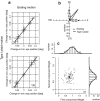

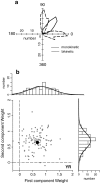


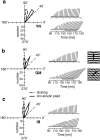
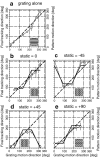

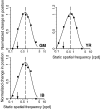


Similar articles
-
Temporal dynamics of motion integration for the initiation of tracking eye movements at ultra-short latencies.Vis Neurosci. 2000 Sep-Oct;17(5):753-67. doi: 10.1017/s0952523800175091. Vis Neurosci. 2000. PMID: 11153655
-
Responses of neurons in macaque MT to unikinetic plaids.J Neurophysiol. 2019 Nov 1;122(5):1937-1945. doi: 10.1152/jn.00486.2019. Epub 2019 Sep 11. J Neurophysiol. 2019. PMID: 31509468 Free PMC article.
-
Temporal dynamics of 2D motion integration for ocular following in macaque monkeys.J Neurophysiol. 2010 Mar;103(3):1275-82. doi: 10.1152/jn.01061.2009. Epub 2009 Dec 23. J Neurophysiol. 2010. PMID: 20032230
-
Grating and plaid chrominance motion influences the suppressed ocular following response.Neuroreport. 1999 Feb 5;10(2):387-92. doi: 10.1097/00001756-199902050-00032. Neuroreport. 1999. PMID: 10203340
-
The role of early mechanisms in motion transparency and coherence.Spat Vis. 1993;7(2):125-47. doi: 10.1163/156856893x00324. Spat Vis. 1993. PMID: 8347549 Review.
Cited by
-
The initial disparity vergence elicited with single and dual grating stimuli in monkeys: evidence for disparity energy sensing and nonlinear interactions.J Neurophysiol. 2008 Nov;100(5):2907-18. doi: 10.1152/jn.90535.2008. Epub 2008 Sep 3. J Neurophysiol. 2008. PMID: 18768642 Free PMC article.
-
Difference in perceptual and oculomotor responses revealed by apparent motion stimuli presented with an interstimulus interval.J Neurophysiol. 2015 May 1;113(9):3219-28. doi: 10.1152/jn.00647.2014. Epub 2015 Mar 25. J Neurophysiol. 2015. PMID: 25810485 Free PMC article.
-
Integration of Contour and Terminator Signals in Visual Area MT of Alert Macaque.J Neurosci. 2004 Mar 31;24(13):3268-80. doi: 10.1523/JNEUROSCI.4387-03.2004. J Neurosci. 2004. PMID: 15056706 Free PMC article.
-
Human ocular following: evidence that responses to large-field stimuli are limited by local and global inhibitory influences.Prog Brain Res. 2008;171:237-43. doi: 10.1016/S0079-6123(08)00633-X. Prog Brain Res. 2008. PMID: 18718307 Free PMC article.
-
Slightly perturbing the arm influences choices between multiple targets.Atten Percept Psychophys. 2023 Aug;85(6):1777-1783. doi: 10.3758/s13414-023-02680-x. Epub 2023 Feb 28. Atten Percept Psychophys. 2023. PMID: 36854925 Free PMC article.
References
-
- Adelson EH, Movshon JA. Phenomenal coherence of moving visual pattern. Nature. 1982;300:523–525. - PubMed
-
- Albrecht DG, Hamilton DB. Striate cortex of monkey and cat: Contrast response function. J Neurophysiol. 1982;48:217–237. - PubMed
-
- Albright TD. Form-cue invariant motion processing in primate visual cortex. Science. 1992;255:1141–1143. - PubMed
-
- Boulton JB, Baker CL. Motion detection is dependent on spatial frequency not size. Vision Res. 1991;31:77–87. - PubMed
Publication types
MeSH terms
LinkOut - more resources
Full Text Sources
